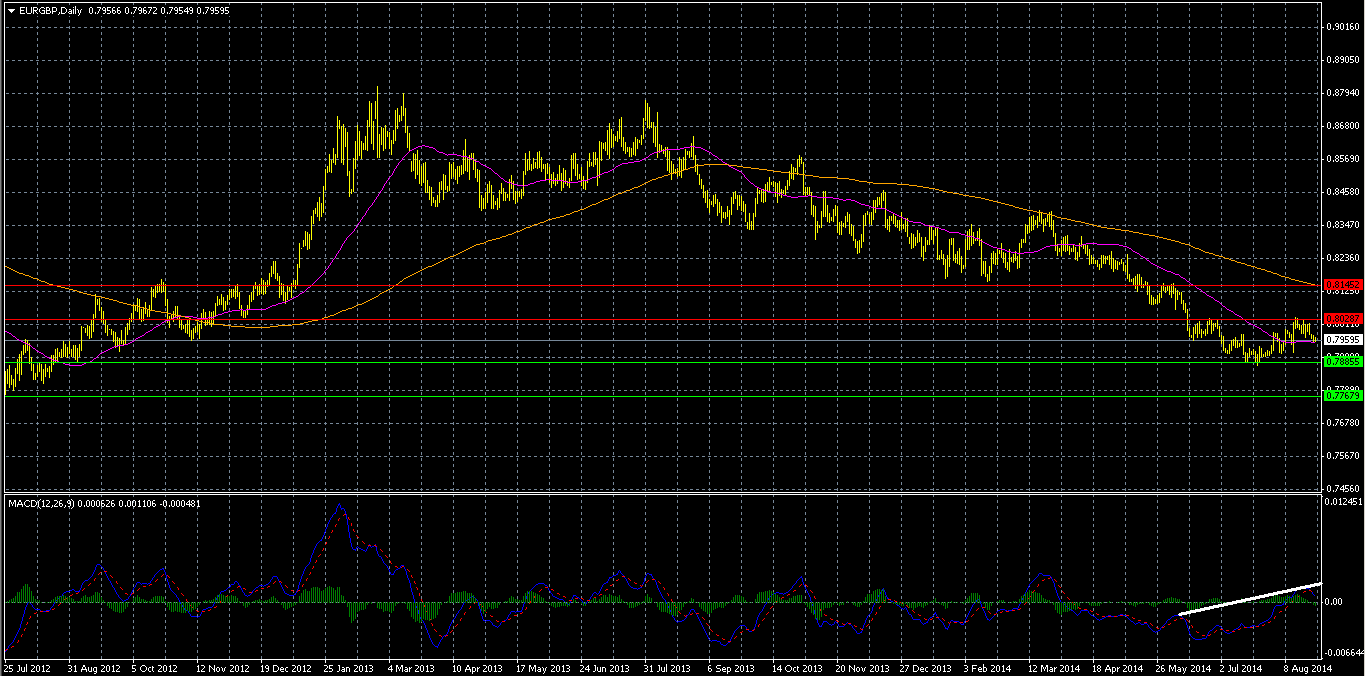The Euro bloc is really struggling to keep the current recovery alive. If the ECB (European Central Bank) do not adjust monetary policy than the Euro bloc may head back into recession and face a deflationary spiral. Most investors are looking at QE (Quantitative Easing) to sort out the current issue in the Euro bloc. QE will help stimulate growth, reduce deflationary pressures and provide a weaker currency. In essence, the ECB really need QE. Inflation is dwindling, the Euro bloc may start to face a similar situation to Japan, if no action is taken. Inflation has fallen drastically (Final CPI y/y, Actual: 0.4%, Forecast: 0.4%, Previous: 0.4%, 14/08/2014). This is becoming worse by consumers holding purchases off in anticipation of lower inflation. This will further increase the chance of a deflationary spiral. This is just one problem the ECB are facing, there are many others. The second largest economy in the Euro Bloc (France) has stated that it will miss budget deficit targets and forecasts of growth are not more than 1%. This shows the amount of strain the Euro Bloc is going through at the moment.
On the other side of the English Channel, the UK is generally doing very well. One cause of concern for investors was CPI y/y data (Actual: 1.6%, Forecast: 1.8%, Previous: 1.9%, 19/08/2014), which signifies that the BoE (Bank of England) will not be raising interest rates in the near-term. In addition, wages are not in line with inflation, which is one of the main concerns the BoE has. If wages grow then this could unlock further growth for the UK economy. In addition, if they don’t then consumer expenditure will be hit. This in turn, will affect the UK negatively. The UK needs more data to justify a rate hike.


The pair was in a downtrend and has now consolidated in a sideways market between S1 and R1. We have identified R1 as a strong ceiling for the pair, the pair has tested this level twice and the pair has failed to break it. R2 is also a strong resistance level, it has been tested once during the downtrend and the pair failed to break it.
We have identified S1 to be a strong floor for the pair, the pair has tested this level twice and the pair has failed to break it. S2 is the lowest the pair the has been since mid-July 2012. The pair has only tested this level once and has failed to break it.
Technicals: MACD (Moving Average Convergence Divergence) and MAs (Moving Averages)
- 50-day MA (magenta) has flat lined and 200-day MA (orange) is in downtrend signalling a loss in momentum of the pair. 200-day MA and 50-day MA will provide additional resistance and support to the pair respectively
- MACD is above zero and above the red signal line. In addition, MACD is in an uptrend, whilst the pair is in sideways which signals that the pair may gain enough momentum to test R1.
In addition, the BoE are probably going to be the first central bank amongst the ECB and Fed to raise interest rates.
CFDs, spread betting and FX can result in losses exceeding your initial deposit. They are not suitable for everyone, so please ensure you understand the risks. Seek independent financial advice if necessary. Nothing in this article should be considered a personal recommendation. It does not account for your personal circumstances or appetite for risk.
Recommended Content
Editors’ Picks
EUR/USD edges lower toward 1.0700 post-US PCE

EUR/USD stays under modest bearish pressure but manages to hold above 1.0700 in the American session on Friday. The US Dollar (USD) gathers strength against its rivals after the stronger-than-forecast PCE inflation data, not allowing the pair to gain traction.
GBP/USD retreats to 1.2500 on renewed USD strength

GBP/USD lost its traction and turned negative on the day near 1.2500. Following the stronger-than-expected PCE inflation readings from the US, the USD stays resilient and makes it difficult for the pair to gather recovery momentum.
Gold struggles to hold above $2,350 following US inflation

Gold turned south and declined toward $2,340, erasing a large portion of its daily gains, as the USD benefited from PCE inflation data. The benchmark 10-year US yield, however, stays in negative territory and helps XAU/USD limit its losses.
Bitcoin Weekly Forecast: BTC’s next breakout could propel it to $80,000 Premium

Bitcoin’s recent price consolidation could be nearing its end as technical indicators and on-chain metrics suggest a potential upward breakout. However, this move would not be straightforward and could punish impatient investors.
Week ahead – Hawkish risk as Fed and NFP on tap, Eurozone data eyed too

Fed meets on Wednesday as US inflation stays elevated. Will Friday’s jobs report bring relief or more angst for the markets? Eurozone flash GDP and CPI numbers in focus for the Euro.